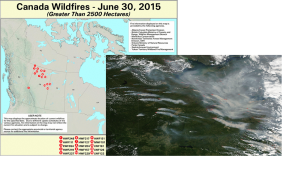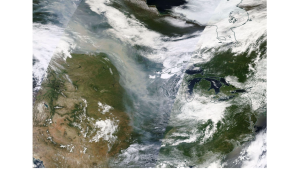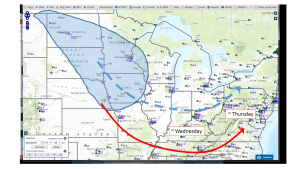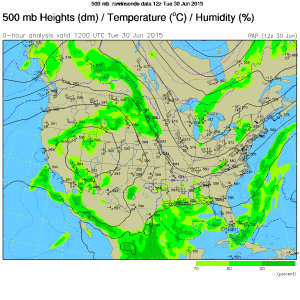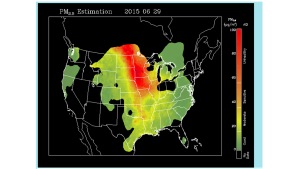Medium Range Air Quality Outlook
Mid-Atlantic Region
Issued: Tuesday, June 30, 2015
Valid: July 1 – 5, 2015 (Wednesday – Sunday)
Summary:
The main features of the medium range period are the threat of smoke from Canadian and Alaskan wildfires and an oscillating frontal boundary that will bring daily clouds and precipitation to parts of the region. The best chances for USG ozone and upper Moderate PM2.5 are during the first part of the period, when mostly sunny skies and light winds will promote deteriorating air quality along the I-95 Corridor. The main question is the possible effect of the wildfire smoke, which is currently impacting surface air quality along the northern Plains. Westerly back trajectories are expected to transport wildfire smoke into the Mid-Atlantic as early as Wednesday. Depending on when the smoke reaches the Mid-Atlantic and how dense it is, another high ozone and PM2.5 day, comparable in extent to the exceedance day on June 11 but lower in magnitude, is possible. On Thursday, a cold front will approach the Mid-Atlantic, promoting scattered clouds and precipitation. This front is expected to stall in the central Mid-Atlantic Thursday evening and remain there as it oscillates between the Mason-Dixon Line and the VA/NC border for the rest of the medium range period. Behind this front, winds are expected to die down as surface high pressure builds in on Thursday and Friday, leading to continued chances for USG ozone in the northern Mid-Atlantic. More widespread clouds and precipitation and onshore surface winds on Saturday and Sunday decrease the chances for USG ozone to slight.
Discussion:
The 06Z NAM, 06Z GFS, and 00Z ECMWF were consulted for this analysis. WPC recommends a blend of the GFS and EC guidance with an emphasis on the GFS; as a result, we relied mainly on these two models for this analysis. The longwave trough in place over the eastern US will persist for the beginning of the medium range period. By the weekend, it will become less pronounced as a weak ridge moves over the Mid-Atlantic from the west. Today, shortwaves embedded within the longwave trough over the Great Lakes will help to pull several waves of low pressure at the surface northeastward into QC. By 06Z Thursday, the models form a closed low at 500 mb over central QC. As this feature slowly moves eastward, it will pull a cold front into the Mid-Atlantic on Wednesday into Thursday morning. This front is expected to stall in the same place that most fronts have stalled in recent weeks: in the vicinity of central VA/southern Delmarva. Subsequently, the stalled front will oscillate northward and southward between the Mason-Dixon Line and the VA/NC border through the rest of the period. Aloft, a weak ridge of high pressure will develop over the Great Lakes on Thursday evening and will move gradually eastward on Friday. At the surface, the center of this area of high pressure will move into the Great Lakes behind Wednesday’s cold front and move eastward, reaching western NY on Friday morning. Aloft, shortwaves will move southward from SK into the Plains on Thursday. They will become more organized and form a wave of low pressure in the central Plains on Thursday evening along the westward extension of the stalled frontal boundary. The wave of low pressure in the central Plains will move eastward, riding along the stalled frontal boundary, reaching the Mid-Atlantic on Saturday. More shortwaves will move overhead on Sunday as the front continue to oscillate in the central Mid-Atlantic (CMA). A weak ridge centered over the Great Lakes will move over the northern Mid-Atlantic on Sunday ahead the next approaching cold front.
High PM2.5 is the main threat over the coming days as Canadian wildfire smoke continues to funnel into the Northern Plains. The smoke is evident this morning in visible satellite imagery, reaching as far south as MO, northern AR, eastern KY, and eastern TN. The smoke is definitely reaching the surface, as shown by this morning’s hourly concentration observations, which are as high as the mid 40 ug/m3 in parts of IA. Back trajectories tomorrow are from southern IL/IN, which is currently at the eastern most edge of the smoke plume. Trajectories from IDEA suggest that the densest smoke will arrive in the southern Mid-Atlantic (SMA; NC and VA) on Wednesday. In the absence of the NRL NAAPS model, which has not run since Friday, we will have to rely on the IDEA trajectories and the NOAA/EPA smoke model, which only provides 1-2 days of guidance. As a result, we expect that PM2.5 concentrations will rise substantially throughout the Mid-Atlantic by Thursday, but we will have to monitor the fate of the smoke closely over the next several days.
Given the continued repetitive and stagnant pattern through the medium range period, there is a chance for clouds and precipitation daily at least somewhere in the Mid-Atlantic. No day will be a washout, but with an oscillating frontal boundary persisting, showers and clouds will be present each day, mainly across the SMA. The main impact for air quality is that in locations where there is clearing, light surface winds and strong late June sun will set the stage for possible upper Moderate to isolated USG ozone. However, given the uncertainty in predicting the exact location of the oscillating frontal boundary, as well as the uncertain impacts of the wildfire smoke, the daily locations of the highest ozone and PM2.5 concentrations are impossible to predict at this point.
With a weak wave of surface low pressure centered over eastern PA on Wednesday morning, surface winds will be sustained throughout the day. A cold front will enter PA from the northwest in the afternoon, reaching roughly to central PA by 00Z Thursday. The models are not showing much precipitation associated with the frontal passage. Aside from possible pop-up showers in the afternoon, it will be mostly sunny in the Mid-Atlantic. A surface trough will extend southward from the center of low pressure along the I-95 Corridor and through eastern VA. Convergence along this trough axis coupled with extended periods of strong afternoon sun will push ozone concentrations into the Moderate range along and east of the I-95 Corridor, with isolated areas possibly approaching USG conditions. Chances for upper Moderate ozone will depend on how quickly ozone rises this afternoon and the possible impact of the smoke. Without a significant wind shift or period of precipitation, particle concentrations will likely rise from southwest to northeast due to transport of the Canadian wildfire smoke. Locations in SMA will probably see particles reach into the Moderate range by Wednesday afternoon.
On Thursday, the center of low pressure will move southward only to the Delmarva, with the cold front reaching westward across northern VA. Surface winds in the area will die down as the low pressure gradient weakens, making for stagnant air and the continued buildup of local and smoke-related PM2.5 throughout the day on Thursday, with widespread locations in the Moderate range. Along and south of the front, PM2.5 formation and buildup will be highest due to the more humid air mass and continued presence of smoke. Any showers forming as a result of convergence along the front will be light, isolated, and short lived, therefore not providing sufficient precipitation to clean out particles from the atmosphere by Friday. As a result, the highest PM2.5 concentrations will along and south of the front, with some areas reaching the upper Moderate range. While cloud cover is expected to increase overnight Wednesday into Thursday for areas along and south of the front, limiting ozone production, clear skies are still likely in PA and northern MD. These conditions will allow the threat for USG ozone to persist in the northern Mid-Atlantic (NMA) as wildfire smoke lingers and strong sun reaches the surface throughout the day. The main forecast questions will be the location of the front and the impact of smoke.
Friday may be the first day of decreasing PM2.5 concentrations as surface winds shift onshore and trajectories originate from the vicinity of Lake Huron. High pressure building over western NY will help keep the frontal boundary in southern VA, allowing for a mostly clear day throughout the central and northern Mid-Atlantic. The exception will be areas along and south of the front, where clouds and showers will persist. While light onshore winds and cleaner trajectories may help to limit particles on Friday, Independence Day fireworks celebrations will present a more localized threat to air quality, with at least scattered Moderate conditions likely continuing. Abundantly clear skies will continue to promote ozone formation for locations north of central VA, making for a Marginal chance for USG ozone conditions. The main forecast questions will be the continued impact of the wildfire smoke and varying emissions due to holiday travel.
Some hope for better air quality will arrive in the form of a surface wave from the Ohio River Valley on Saturday morning. As it approaches and skirts just south of PA before moving out to sea overnight, it will bring cleaner New England air as well as clouds and scattered rain showers to the entire Mid-Atlantic. However, this wave is a relatively weak one, and although the cloud cover will inhibit ozone formation, the resulting surface convergence may promote the buildup of PM2.5 for another day. Increased particle concentrations are especially probable at inland locations where onshore winds are not likely to help clean out the boundary layer. Sunday will see residual clouds and showers as the surface wave continues eastward and our frontal boundary persists in the central Mid-Atlantic. Clearing is likely in the NMA due to an area of strengthening high pressure in northern PA, possibly continuing the trend of high ozone concentrations in PA and MD.
-Huff/DeBoe/Eherts



